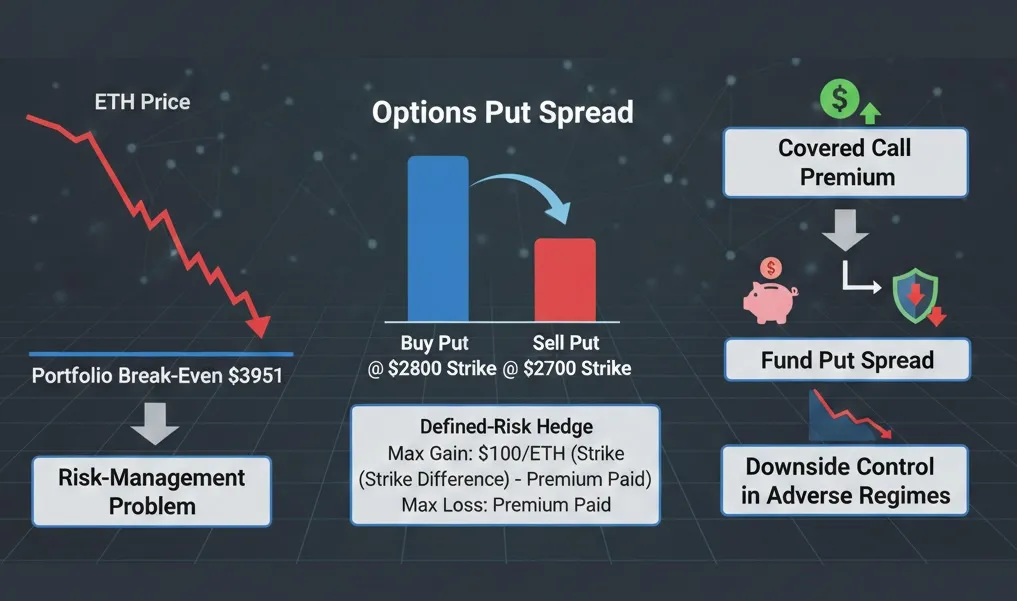Crypto Options
How Put Spreads Help Manage Downside While Selling Covered Calls
| 6 seen

When markets move below our average entry, we treat the situation as a risk-management problem, not a prediction problem. At that point, the priority is simple: avoid turning a manageable drawdown into a deeper one. One of the tools we use for that purpose is the put spread.
To make the logic concrete, here is a real-style example.
On December 18, 2025, Terramatris was holding 2.8 ETH with a portfolio break-even price of $3,951. As part of our systematic income approach, we regularly sell weekly covered calls to generate premium and work our break-even lower over time.…
Crypto Options Prediction Bot — Inside Our Next-Gen AI Trading Engine
| 48 seen
At Terramatris, we’ve spent years exploring the intersection of quantitative finance, machine learning, and blockchain markets.
Our latest internal project - Crypto Options Prediction Bot - represents a major leap in how AI can analyze and rank crypto options across Deribit in real time.
Unlike retail “signal” bots, our bot doesn’t guess. it learns, measures, and scores every BTC and ETH options contract based on statistical probabilities, expected returns, and volatility dynamics.
Fetches live Deribit options data for BTC and ETH every week.Filters all contracts with Friday…How to Repair a Deep-in-the-Money Covered Call in Crypto
| 61 seen

Covered calls are among the most reliable tools for extracting yield in volatile markets. Still, when prices fall sharply, even disciplined positions face pressure. The decision then shifts from profit maximization to risk control and capital efficiency.
In this article, we’ll walk through practical ways to repair a broken covered call, especially when the underlying asset has crashed and the position is deep in the money.
At Terramatris, we primarily trade crypto options, so the examples focus on assets like Ethereum — but the same principles apply to traditional stock…
Trading Covered Calls on XRP with Deribit
| 107 seen

At Terramatris we are always exploring new ways to structure option strategies around crypto assets. One of the more interesting challenges we’ve faced recently is figuring out how to trade covered calls on XRP.
Our favorite trading platform, Bybit, unfortunately does not yet offer XRP options. That left us looking for alternatives, and naturally, Deribit became our next candidate. Deribit does offer XRP options, but as always, the devil is in the details.
The Challenge: Collateral Rules on DeribitDeribit lists XRP options, but they are settled in USDC. At the time of writing,…
Managing Risk: Rolling Forward and Hedging With Trigger-Based Shorts
| 29 seen

In the past week, one of our ETH option positions came under pressure. We were short 1.7 ETH put contracts with a 4100 strike expiring on August 22. With ETH price action weakening, the trade started to look challenged.
At Terramatris, our primary focus is risk management. Collecting option premium is attractive, but holding onto a position that feels unsafe can quickly turn into a liability. We therefore took a hard look at our choices:
Roll forward to a later expiry to keep premium income flowing.Hedge with futures to neutralize delta risk.Combination strategies, blending both…Selling Covered Calls on Borrowed Bitcoin: Strategic Yield with Asymmetric Risk
| 60 seen

On May 25, 2025, we executed a position that perfectly illustrates a niche but compelling setup in the crypto derivatives space. We:
Borrowed 0.01 BTC (worth $1,080 at the time),Posted 0.54 ETH as collateral (worth $1,350),And sold a cash-settled call option on 0.01 BTC with a strike price of $110,000,Collecting a premium of $17 with weekly expiry (May 30).Let’s break down the rationale, benefits, risks, and variations of this strategy — and why, despite its synthetic nature, it can be a valuable tool in Terramatris' option yield strategies.
The Core StrategyThe basic idea is…
How to Sell a Synthetic Covered Call on ETH
| 220 seen
At TerraMatris Crypto Hedge Fund, we actively deploy a range of options strategies to generate income and manage directional exposure. Today, I want to share an elegant and capital-efficient technique we’re using: the synthetic covered call—a method that replicates the payoff profile of a traditional covered call, without the need to hold the underlying crypto asset.
What Is a Synthetic Covered Call?Traditionally, a covered call involves owning a crypto asset (like ETH) and selling a call option against it. This generates premium income while capping upside beyond the strike price.…